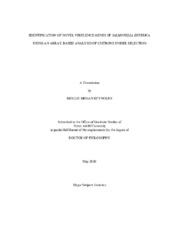| dc.description.abstract | Pools of mutants of minimal complexity but maximal coverage of genes of
interest facilitate screening for genes under selection in a particular environment. Prior to
this work, mutants were generated by random transposon insertions, which yielded
highly complex pools for in vivo studies. Recent advances in polymerase chain reaction
(PCR)-based mutagenesis in bacteria using the lambda red recombinase, as well as
whole genome sequencing, enable a more directed approach for the generation of
mutants. The lambda red approach was used to construct individual mutants in 1,023
Salmonella enterica serovar Typhimurium genes, including almost all genes found in
Salmonella, but not in related genera. All the mutations were confirmed simultaneously
using a novel amplification strategy to produce labeled ribonucleic acid (RNA) from a
T7 RNA polymerase promoter, introduced during the construction of each mutant,
followed by hybridization of this labeled RNA to a Typhimurium genome tiling array.
To demonstrate the ability to identify fitness phenotypes using our pool of mutants, the
pool was subjected to selection by intraperitoneal injection into BALB/c (Bagg Albino)
mice and was recovered from the spleen. Changes in the representation of each mutant were monitored using T7 transcripts hybridized to a novel inexpensive minimal
microarray. Among the top 120 statistically significant spleen colonization phenotypes,
51 were mutations in genes with no previously known role in this model. Fifteen
phenotypes were tested using individual mutants in competitive assays and eleven were
confirmed in individual mixed intraperitoneal infection in mice, including the first two
examples of attenuation for sRNA mutants in Salmonella. We refer to our method as
Array-Based Analysis of Cistrons Under Selection (ABACUS).
Among the confirmed mutants identified in the ABACUS screen was a
component of the twin arginine transport (Tat) system, tatC, required for transport of
folded proteins across the cellular membrane. TatC is the highly conserved component
necessary for recognition of the twin arginine containing signal sequence S/T-R-R-x-FL-
K. We confirmed [delta] tatC mutants are defective for colonization of the liver and spleen
in competitive infections with wild type ATCC14028 after intraperitoneal infection in
Salmonella- susceptible (BALB/c). We also found that [delta] tatC mutants were defective for
swimming motility, but not swarming motility, which was linked to the ability to
elaborate flagellins on the bacterial surface under different conditions. | en |


